Understand geyser sizes to avoid underperformance.
Understand geyser sizes to avoid underperformance.
Blog Article
How to Pick the Right Geyser to Take Full Advantage Of Energy Effectiveness in Your Home
Picking an energy-efficient geyser is not as simple as it seems, calling for cautious analysis of different factors. From understanding the different kinds of geysers, to reviewing their energy performance scores and considering placement technique, each choice plays an important duty in maximizing performance. Balancing the preliminary investment with long-lasting savings is likewise crucial. Allow's embark on this journey to uncover how to make the most enlightened option for a geyser that will lower your energy expenses while ensuring ideal efficiency.

Understanding the Various Kinds Of Geyser
While there are various kinds of geysers offered on the marketplace, comprehending the distinctions between them is vital for energy effectiveness (geyser sizes). The initial type, storage hot springs, are the most typical and shop hot water in a container for usage when needed. They are offered in various capacities and are typically energy-efficient, yet they can shed warmth when not in use
The 2nd kind is the tankless geyser, which warms water on demand, resulting in much less power waste however needing a greater initial power draw. Thirdly, there are warm pump hot springs that make use of electricity to move heat from one place to another as opposed to producing warmth straight. They can be 2 to 3 times a lot more power reliable than standard storage space geysers. Solar geysers use solar energy to heat the water, making them the most energy-efficient but also the most pricey.
Assessing Your Home's Warm water Needs
Prior to diving right into the acquisition of a geyser, it is pivotal to assess the hot water requirements of your house. This analysis should take into consideration countless aspects consisting of the variety of house participants, frequency of hot water use, and the variety of hot water electrical outlets in the home (geyser sizes). A tiny household with infrequent warm water usage might require a smaller, less powerful geyser contrasted to a bigger family members with multiple daily hot water demands
The type of devices that call for warm water also play a significant function. Dish washers and cleaning equipments, for example, might need more warm water than a basic shower or cooking area sink. Details activities such as showering or cleaning also influence the regularity and volume of hot water needed.
Reviewing Energy Performance Scores of Geyser
Having examined the warm water demands of your home, it is necessary to transform your interest to the power efficiency rankings of hot springs. These scores, usually given as Energy Variable (EF), suggest a geyser's overall energy efficiency based on the quantity of hot water produced each of fuel consumed over a regular day. The greater the EF, the more reliable the hot water heater.

Factors To Consider in Geyser Size and Positioning
Beyond energy effectiveness scores, the size and positioning of your geyser are crucial aspects to consider. The dimension of the geyser should align with your family's warm water needs. A little geyser may utilize less energy but may not supply adequate warm water for numerous usages at the very same time, whereas a bigger device can satisfy greater need however may take in more Check This Out power.
Geysers ought to be set up close to points of usage to decrease warm loss throughout water transport. Furthermore, considering thermal insulation, a geyser situated in a warmer area loses less heat and as a result utilizes much less power to maintain the water temperature.
Price Analysis: Balancing Initial Investment and Long-Term Savings
While dimension and placement most certainly play substantial duties in a hot spring's energy effectiveness, one should not ignore the financial facet. When thinking about the preliminary investment, the cost of energy-efficient hot springs can be higher than typical designs. Nonetheless, the enhanced in advance expense can be balanced out by lasting energy savings, making it a useful link rewarding investment in the lengthy run.
Analyzing long-term savings needs an understanding of the geyser's energy score. An appliance with a higher rating will certainly eat much less power, converting to reduced utility expenses in time. Additionally, federal government rewards and discounts for energy-efficient appliances can additionally help recoup preliminary prices.
Finally, maintenance and life expectancy need to be factored in. Energy-efficient hot springs often have much longer life-spans and reduced upkeep costs, adding to general cost savings. When stabilizing preliminary financial investment and lasting cost savings, one must take into consideration not only the acquisition cost but also power intake, government incentives, and maintenance expenses.

Conclusion
These more include comprehending the types of geysers, analyzing your house's hot water needs, evaluating energy performance rankings, and calculating cost benefits. The best geyser dimension, placement, and insulation can significantly reduce power expenses and environmental effect.
Report this page